CBSE Class 12 Physics Chapter 4 Moving Charges And Magnetism Multiple Choice Question And Answers

Question 1. The moving coil galvanometer G1 and G2 have the following particulars respectively:
N1 = 30 , A1 = 3.6 x 10-3m2 , B1 = 0.25 T
N2 = 42 , A2 = 1.8 x 10-3m2, B2 = 0.50 T
The spring constant is the same for both the galvanometers, The ratio of current sensitivities of G1 and G2 is:
- 5:7
- 7:5
- 1:4
- 1:1
Answer: 1. 5:7
Read and Learn More Important Questions for Class 12 Physics with Answers
⇒ \(\frac{\mathrm{I}_{\mathrm{S}_1}}{\mathrm{I}_{\mathrm{S}_2}}=\frac{\mathrm{N}_1 \mathrm{~A}_1 \mathrm{~B}_1}{\mathrm{~K}_1} \times \frac{\mathrm{K}_2}{\mathrm{~N}_2 \mathrm{~A}_2 \mathrm{~B}_2}\)
K1 = K2
So \(\left(\frac{N_1}{N_2}\right)\left(\frac{A_1}{A_2}\right)\left(\frac{B_1}{B_2}\right)\)
= \(\frac{30}{42} \times \frac{3.6 \times 10^{-3}}{1.8 \times 10^{-3}} \times \frac{0.25}{0.50}\)
= \(\frac{5}{7} \times 2 \times \frac{1}{2}\)
= 5:7
CBSE Class 12 Physics Chapter 4 Question 2. A current 1 is flowing through the loop as shown in the figure ( MA = R, MB = 2R ). The magnetic field at the center of the loop is \(\left(\frac{\mu_0 I}{R}\right)\) times:
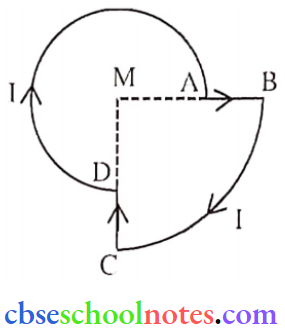
- \(\frac{5}{16}\) in to the plane of paper
- \(\frac{5}{16}\) Out to the plane of paper
- \(\frac{7}{16}\) in to the plane of paper
- \(\frac{7}{16}\) out to the plane of paper
Answer: 4. \(\frac{7}{16}\) out to the plane of paper
B = BDA(x)+BAC(x)
= \(\frac{3}{4} \times \frac{\mu_0 \mathrm{I}}{2 \mathrm{R}}+\frac{1}{4} \times \frac{\mu_0 \mathrm{I}}{2(2 \mathrm{R})}\)
= \(\frac{3}{8} \frac{\mu_0 I}{R}+\frac{1}{16} \frac{\mu_0 I}{R}\)
= \(\frac{\mu_0 \mathrm{I}}{\mathrm{R}}\left(\frac{3}{8}+\frac{1}{16}\right)\)
= \(\frac{\mu_0 I}{R}\left(\frac{6+1}{16}\right)\)
B = \(\frac{7}{16} \frac{\mu_0 I}{R}\)
Question 3. A long straight wire in the horizontal plane carries a current of 15A in north to south direction. The magnitude and direction of the magnetic field at a point 2.5 m east of the wire respectively are:
- 1.2 μT, vertically upward
- 1.2 μT, vertically downward
- 0.6 μT, vertically upward
- 0.6 μT vertically downward
Answer: 1. 1.2 μT, vertically upward

B = \(\frac{\mu_0 \mathrm{I}}{2 \pi \mathrm{r}}=\frac{4 \pi \times 10^{-7} \times 15}{2 \pi \times 2.5}=1.2 \mu \mathrm{T}\) (Vertically upwards)
CBSE Class 12 Physics Chapter 4 Question 4. An electron is projected with velocity \(\vec{V}\) along the axis of a current carrying a long solenoid. Which of the following statements is true?
- The path of the electron will be circular about the axis
- The electron will be accelerated along the axis
- The path of the electron will be helical
- The electron will continue to move at the same velocity v along the axis of the solenoid.
Answer: 4. The electron will continue to move at the same velocity v along the axis of the solenoid.
Question 5. If the speed v of a charged particle moving in a magnetic field \(\vec{B}\) (\(\vec{v}\) is perpendicular to \(\vec{B}\)) is halved, then the radius of its path will:
- Not change
- Become two times
- Become one-fourth
- Become half
Answer: 4. Become half
∴ \(r=\frac{m v}{q B}\)
Question 6. Which of the following is not affected by the presence of a magnetic field?
- A current-carrying conductor
- A moving charge
- A stationary charge
- A rectangular current loop with its plane parallel to the field
Answer: 3. A stationary charge
Question 7. Identical thick wires and two identical thin wires, all of the same material and the same length form a square in three different ways P, Q, and R as shown. Due to the current in these loops, the magnetic field at the center of the loop will be zero with ease of
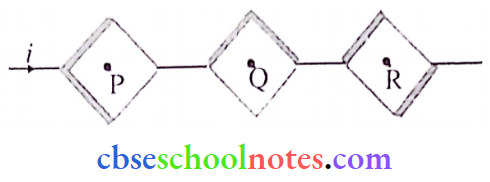
- P and R only
- Q and R only
- P and Q only
- P, Q, and R
Answer: 1. P and R only
Question 8. A circular coil carrying a certain current produces a magnetic field B0 at its center. The coil is now rewound to have three turns and the same current is passed through it. The magnetic field at the center is
- 3B0
- \(\frac{B_0}{3}\)
- \(\frac{B_0}{9}\)
- 9B0
Answer: 4. 9B0
Lel coil is of N turns and radius R, \(B_0=\frac{\mu_0 I}{2 R}\)
2πR = length of wire
Now, 2R = 3 x 2πR’
So, \(R^{\prime}=\frac{R}{3}\)
∴ \(B^{\prime}=\frac{\mu_0 I \times 3}{2\left(\frac{R}{3}\right)}=9\left(\frac{\mu_0 I}{2 R}\right)=9 B_0\)
CBSE Class 12 Physics Chapter 4Question 9. A long solenoid carrying current produces a magnetic field B along its axis, if the number of turns in the solenoid is halved and the current in it is doubled, the new magnetic field will be:
- B/2
- B/2
- 2B
- 4B
Answer: 2. B/2
⇒ \(\overrightarrow{\mathrm{F}}=\mathrm{q}(\overrightarrow{\mathrm{v}} \times \overrightarrow{\mathrm{B}})\)
⇒ \(\overrightarrow{\mathrm{F}}=1.6 \times 10^{-19}[(4 \hat{\mathrm{i}}+3 \hat{\mathrm{k}}) \times(3 \hat{\mathrm{k}}+4 \hat{\mathrm{i}})]\)
⇒ \(\left|\begin{array}{ccc}
\hat{i} & \hat{j} & \hat{k} \\
4 & 0 & 3 \\
4 & 0 & 3
\end{array}\right|\)
⇒ \(\hat{\mathrm{i}}(0)-\hat{\mathrm{j}}(12-12)+\hat{\mathrm{k}}(0)\)
= 0
So, \(\overrightarrow{\mathrm{F}}=0\)
Question 10. A current-carrying square loop is suspended in a uniform magnetic field acting in the plane of the loop. If the force on one arm of the loop is F, the net force on the remaining three arms of the loop will be:-
- \(3{\vec{F}}\)
- \(-3{\vec{F}}\)
- \({\vec{F}}\)
- \(-\vec{F}\)
Answer: 4. \(-\vec{F}\)
Question 11. The electron performs circular motion in a circle of radius r, perpendicular to a uniform magnetic field B. The kinetic energy gained by this electron in half the revolution is __________.
- \(\frac{1}{2} m v^2\)
- \(\frac{1}{4} m v^2\)
- Zero
- πrBeV
Answer: 3. Zero
Work done is zone
Because v ⊥ B
So ΔK = W = 0.
Question 12. At a place, an electric field and a magnetic field are in a downward direction. There an electron moves in a downward direction. Hence this electron.
- Will bend towards left
- Will bend towards the right
- Will gain velocity
- Will lose velocity
Answer: 4. Will lose velocity
Question 13. When a charged particle moves in a magnetic field its kinetic energy.
- Remains Constant
- Increases
- Can decrease
- Become zero
Answer: 1. Remains Constant
Question 14. A charged particle moves with velocity v in a uniform magnetic field B. The magnetic force acting on it will be maximum when.
- \(\vec{V}\) and \(\vec{B}\) arc in same direction.
- \(\vec{V}\) and \(\vec{B}\) are in opposite direction.
- \(\vec{V}\) and \(\vec{B}\) are mutually perpendicular.
- \(\vec{V}\) and \(\vec{B}\) make an angle of 45° with each other.
Answer: 3. \(\vec{V}\) and \(\vec{B}\) are mutually perpendicular.
Question 15. There are 100 turns per cm length in a very long solenoid. It carries a current of 2.5 A. The magnetic field at its center on the axis is __________ T.
- 3.14 x 10-2
- 9.42 x 10-2
- 6.28 x 10-2
- 12.56 x 10-2
Answer: 1. 3.14 x 10-2
B = μ0 nI
⇒ \(4 \times 3.14 \times \frac{100}{10^{-2}} \times 2.5 \times 10^{-7}\)
⇒ 3.14 x 10-2T
Question 16. A toroid wound with 100 turns per m of wire carries a current of 3 A. The core of the toroid is made of iron having relative magnetic permeability μr = 5000. The magnetic field inside the iron is __________. (μ0 = 4π x 10-7 T mA-1)
- 0.15 T
- 1.5 x 10-2T
- 0.47 T
- 1.88 T
Answer: 4. 1.88 T
B = μ0 nI
= 5000 x 4 x 3.14 x 10-7 x 100 x 3
B = 1.88 T
Question 17. Two parallel long thin wires, each carrying current I are kept at a separation r from each other. Hence the magnitude of force per unit length of one wire due to the other wire is _________.
- \(\frac{\mu_0 I^2}{2 \pi r}\)
- \(\frac{\mu_0 I^2}{r^2}\)
- \(\frac{\mu_0 \mathrm{I}}{2 \pi \mathrm{r}}\)
- \(\frac{\mu_0 \mathrm{I}}{2 \pi \mathrm{r}^2}\)
Answer: 1. \(\frac{\mu_0 I^2}{2 \pi r}\)
Question 18. Two concentric rings are kept in the same plane. The number of turns in both rings is 25. Their radii are 50 cm and 200 cm and they carry electric currents of 0.1 A and 0.2 A respectively, in mutually opposite directions. The magnitude of the magnetic field produced at their center is __________T.
- 2μ0
- 4μ0
- \(\frac{10}{4} \mu_0\)
- \(\frac{5}{4} \mu_0\)
Answer: 4. \(\frac{5}{4} \mu_0\)
⇒ \(\overrightarrow{\mathrm{B}}=\overrightarrow{\mathrm{B}}_1+\overrightarrow{\mathrm{B}}_2\)
⇒ \(\frac{\mu_0 N_1 I_1}{2 R_1}-\frac{\mu_0 N_2 I_2}{2 R_2}=\frac{\mu_0 \times 25}{2}\left(\frac{0.1}{0.5}-\frac{0.2}{2}\right)=\frac{5}{4} \mu_0\)
Question 19. The current sensitivity of the galvanometer is inversely proportional to _________.
- Torsional constant
- Number of turns
- Area
- Magnetic field
Answer: 1. Torsional constant
Question 20. Parallel currents ______ and antiparallel currents _______.
- Attract, Attract
- Repel, attract
- Attract, repel
- Repel, repel
Answer: 3. Attract, repel
Question 21. A solenoid of length 0.5 m has a radius of 1 cm and it is made up of 500 turns. If the magnitude of the magnetic field inside the solenoid is 6.28 x 10-3 T then it carries a current of _________ A.
- 4
- 5
- 2
- 10
Answer: 2. 5
B = μ0nI
Solve I
I = \(\frac{\mathrm{B}}{\mu_{\mathrm{o}} \mathrm{n}}\left[\mathrm{n}=\frac{\mathrm{N}}{\ell}=\frac{500}{0.5}=1000 \text { turns } / \mathrm{m}\right]\)
∴ \(\frac{6.28 \times 10^{-3}}{4 \pi \times 10^{-7} \times 1000}=5 \mathrm{~A}\)
Moving Charges And Magnetism Assertion And Reason
For question numbers 1 to 7 two statements are given-one labelled Assertion (A) and the other labelled Reason (R). Select the correct answer to these questions from the codes (1). (2). (3) and (4) as given below.
- Both A and R are true and R is the correct explanation of A
- Both A and R are true but R is NOT the correct explanation of A
- A is true but R is false
- A is false and R is also false
Question 1. Assertion: When a charged particle moves with velocity v in a magnetic field B (v⊥B). the force on the particle does not work.
Reason: The magnetic force is perpendicular to the velocity of the particle.
Answer: 1. Both A and R are true and R is the correct explanation of A
Question 2. Assertion: The magnetic moment of the toroid is zero.
Reason: The magnetic field outside the volume of the carrying toroid is zero.
Answer: 2. Both A and R are true but R is NOT the correct explanation of A
Question 3. Assertion: Two charge particles at rest experience only electrostatic force.
Reason: Charges at rest can only produce an electrostatic field.
Answer: 1. Both A and R are true and R is the correct explanation of A
Question 4. Assertion: A moving charged particle gets energy from a magnetic field.
Reason: Magnetic force works on moving charged particles.
Answer: 4. A is false and R is also false
Question 5. Assertion: The coil is wound over the metallic frame in a moving coil galvanometer.
Reason: The metallic frame helps in making steady deflection without any oscillation.
Answer: 1. Both A and R are true and R is the correct explanation of A
Question 6. Assertion: When the magnet is brought near iron nails, only translatory force acts on it.
Reason: The field due to a magnet is generally uniform.
Answer: 4. A is false and R is also false
Question 7. Assertion: The higher the range of an ammeter, the smaller its resistance.
Reason: To increase the range of the ammeter, the additional shunt needed to be connected across it.
Answer: 1. Both A and R are true and R is the correct explanation of A.
Moving Charges And Magnetism Short Question And Answers
Question 1.
- Write the relation for the force acting on a charged particle q moving with velocity \(\vec{v}\) in the presence of a magnetic field \(\vec{B}\).
- A proton is accelerated through a potential difference V, subjected to a uniform magnetic Held acting normal to the velocity of the proton. If the potential difference is doubled, how will the radius of the circular path described by the proton in the magnetic field change?
Answer:
1. \(\vec{F}=q(\vec{v} \times \vec{B})\)
2. \(r=\frac{m v}{q B}=\frac{\sqrt{2 m(K E)}}{q B}\) [mv = P = \(\sqrt{2 \mathrm{mK}}\)] (K → K.E)
= \(\frac{\sqrt{2 m(q V)}}{q B} r \propto \sqrt{V}\)
Thus if V2 = 2V1 = r2 = √2r1.
Question 2. In the figure given below, wire PQ is fixed while the square loop ABCD is free to move under the influence of currents flowing in them. State with reason, in which direction does the loop begin to move or rotate?
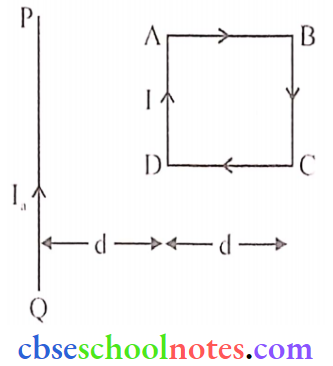
Answer:
Forces on side AB and CD cancel each other, Now force on AD is attractive due to the similar direction of current, and on side BC force is repulsive due to the opposite direction of current.
As side AD is nearer to wire PQ as compared to BC so force on side AD (attractive) is more than the force on side BC ( repulsive), so square loop ABCD does move towards wire PQ.
Question 3.
- A proton and an electron traveling along parallel paths enter a region of uniform magnetic field, acting perpendicular to their paths. Which of them will move in a circular path with higher frequency?
- What can be the cause of the helical motion of a charged particle?
Answer:
1. We know that, frequency
\(v=\frac{\mathrm{q} B}{2 \pi \mathrm{m}} \text { and } \mathrm{m}_{\mathrm{e}}<<\mathrm{m}_{\mathrm{p}}\)
So electrons will move with a higher frequency
2. When a charged particle moves in a uniform external magnetic field, with velocity not perpendicular or parallel to the magnetic field, (Means : 0° < θ < 90°) then the charged particle experiences a force also along with torque and performs the helical motion.
Question 4. Draw the magnetic field lines due to a current passing through a long solenoid.
Answer:
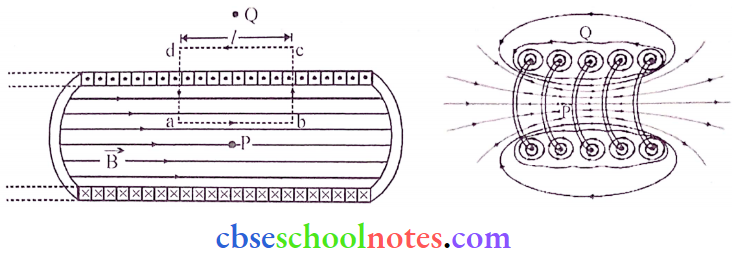
Question 5. Find the condition under which the charged particles moving with different speeds in the presence of electric and magnetic field vectors can be used to select charged particles of a particular speed.
Answer:
Consider a charge ’q’ moving with velocity \(\vec{v}\) in the presence of both electric field \(\vec{E}\) and magnetic field \(\vec{B}\) experience a force given as
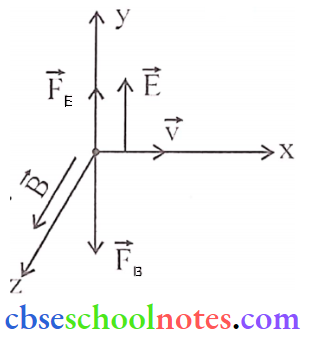
⇒\(\overrightarrow{\mathrm{F}}=\mathrm{q}(\overrightarrow{\mathrm{E}}+\overrightarrow{\mathrm{v}} \times \overrightarrow{\mathrm{B}})=\overrightarrow{\mathrm{F}}_{E}+\overrightarrow{\mathrm{F}}_{\mathrm{B}}\)
Assume, that \(\vec{E}\) and \(\vec{B}\) are ⊥ to each other and also to the velocity of the particle.
Directions of electric force \(\left(\vec{F}_{E}\right)\) and magnetic force \(\left(\vec{F}_{B}\right)\) are just opposite.
∴ \(\vec{F}=q(E-v B) \hat{j}\)
if magnitudes of electric and magnetic force are equal then, the net force on the particle is zero and it will move undeflected in the fields.
qE = qvB or V = E/B
The above condition is used to select charged particles of a particular velocity.
Question 6.
- Write the expression for the magnitude of the magnetic force acting on a charged particle moving with velocity v in the presence of magnetic field B.
- A neutron, an electron, and an alpha particle moving with equal velocities enter a uniform magnetic field going into the plane of the paper as shown. Trace their paths in the field and justify your answer.
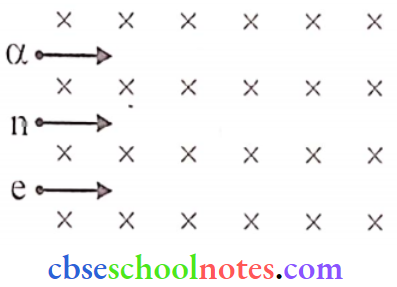
Answer:
1. Force acting on a charged particle q which is moving with velocity v in magnetic field B is given by \(\vec{F}=q(\vec{v} \times \vec{B})\)
Fleming’s left-hand rule gives the direction of the force. The direction of the force is perpendicular to the plane containing velocity \(\vec{v}\) and magnetic field \(\vec{B}\).
2. A charged particle experiences a force when it enters the magnetic field. Due to the presence of a magnetic field, the charged particle will move in a circular path because the force is perpendicular to the velocity of the charged particle, required centripetal force will be provided by magnetic force.
The radius of the circular path in which the charged particle is moving is “given by r = mv/qB since v and B are constant so the radius of the path of the particle is proportional to their mass to charge ratio.
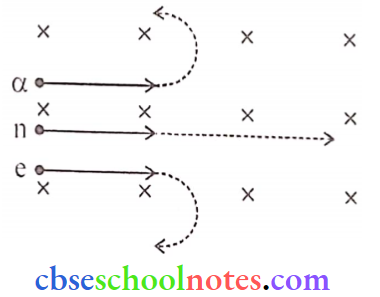
Alpha-particle will trace a circular path in an anti-clockwise sense and its deviation will be in the direction of \((\vec{v} \times \vec{B})\)
Nculion will pass without any deviation as the magnetic field does not exert force on the neutral particle.
Electron will trace a circular path in a clockwise sense as its deviation is in the direction opposite to \((\vec{v} \times \vec{B})\) with a smaller radius due to mass or charge.
Question 7. Two long straight parallel conductors are carrying steady current I1 and I2 separated by a distance d. if the currents are flowing in the same direction, show how the magnetic field set up in one produces an attractive force on the other. Obtain the expression for this force. Hence define one ampere.
Answer:
We consider two long conductors X1 Y1 and X2Y2 placed parallel to each other at a distance of d apart. The current I1 and I2 are flowing as shown in the diagram. The magnetic field at point P (on the conductor X1Y1 due to current I2 flowing through the long conductor X2Y2) is g given by
⇒ \(\mathrm{B}_2=\frac{\mu_0 \mathrm{I}_2}{2 \pi \mathrm{d}}\) →(1)

According to the right-hand rule, the direction of the magnetic field B2 at point P is perpendicular to the plane of the paper and in an inward direction. Now, the conductor X1 Y1 carrying current I1 lies in the magnetic field B, produced by the conductor X2Y2.
Since F=BIl, the force experienced by the unit length of the conductor X1Y1 due to magnetic field B2 is given by
⇒ \(\mathrm{F}=\mathrm{B}_2 \cdot\left(\mathrm{I}_1 \cdot \ell\right)=\frac{\mu_0 \mathrm{I}_1 \mathrm{I}_2}{2 \pi \mathrm{d}}\) → (2)
or
⇒ \(\frac{F}{l}=\frac{\mu_0 I_1 I_2}{2 \pi d}\)
Applying Fleming’s left-hand rule, it follows that the force F on the conductor X1Y1 acts in the plane of the paper and towards the left. If we proceed similarly then it can be proved that the conductor X2Y2 experiences an equal force in the plane of the paper but towards the right.
Therefore, the two parallel conductors carrying current in the same direction attract each other.
Definition of Ampere: Let I1 = I2 = I A and d = 1 m
Then from eq (1), we have that
F = 2x 10-7 N/mK
This means that one ampere of current is that much current which when flown through two infinitely long parallel conductors separated by one meter in free space, causes a force of 2 x 10-7 N per meter on each conductor.
Question 8. A rectangular coil of sides ‘l’ and ‘b’ carrying a current I is subjected to a uniform magnetic field \(\vec{B}\) acting perpendicular to its plane. Obtain the expression for the torque acting on it.
Answer:
Consider a rectangular conducting loop (PQRS) of length l and b breadth b placed in a uniform magnetic field. Let I be the current flowing in the loop in a clockwise direction. Let at any instant the angle between the magnetic field and normal to the rectangular coil is θ.
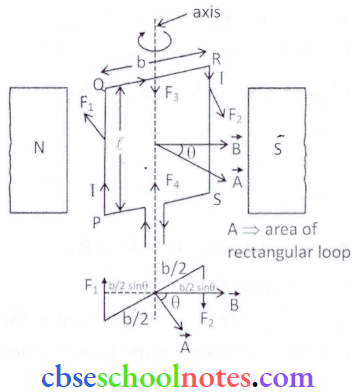
Force acting on the ann PQ in the loop,
⇒ \(\overrightarrow{\mathrm{F}}_1=\mathrm{I}(\vec{\ell} \times \overrightarrow{\mathrm{B}}) \Rightarrow \mathrm{F}_1=\mathrm{IB} \ell\) (Directed inside the sheet of paper)
Similarly, the force acting on the arm RS of the loop,
⇒ \(\overrightarrow{\mathrm{F}}_2=\mathrm{I}(\vec{\ell} \times \overrightarrow{\mathrm{B}}) \Rightarrow \mathrm{F}_2=\mathrm{IB} \ell\) (Directed outside the sheet of paper)
Force \(\overrightarrow{\mathrm{F}}_3\) acting on the arm QR and force \(\overrightarrow{\mathrm{F}}_4\) acting on the arm SP of the loop are equal, opposite and act along the same line, hence they cancel each other. Therefore only two forces \(\overrightarrow{\mathrm{F}}_1\) and \(\overrightarrow{\mathrm{F}}_2\) act on the loop. \(\) and form a couple and try to rotate the loop clockwise. The magnitude of the torque(τ) due to forces \(\overrightarrow{\mathrm{F}}_1\) and \(\overrightarrow{\mathrm{F}}_2\) is given by
τ = Magnitude ol the either force x Perpendicular distance between forces
τ = IlB x b sin θ { l x b = A, area of the loop}
r = I A B sinθ
In vector form \(\vec{\tau}=I(\overrightarrow{\mathrm{A}} \times \overrightarrow{\mathrm{B}})\)
If the loop has N turns, then the net torque acting on the loop is
τ = BINA sinθ
τ = M B sinθ
∴ \(\vec{\tau}=\overrightarrow{\mathrm{M}} \times \overrightarrow{\mathrm{B}}\)
CBSE Class 12 Physics Chapter 4 Question 9. How is a galvanometer converted into a voltmeter and an ammeter? Draw the relevant diagrams and find the resistance of the arrangement in each case. Take the resistance of the galvanometer as G.
Answer:
Conversion of Galvanometer into Voltmeter:
Voltmeter is used to measure p.d. so it is connected in parallel, in a circuit and its resistance should be infinite in the ideal case, thus to maximize the resistance of the galvanometer according to the required range we connect a suitable resistance in series as shown:

If the potential difference between the points to be measured = V and if
the galvanometer gives full-scale deflection when current “Ig” passes through it. Then.
⇒ \(V=I_g\left(R_g+R_X\right) \Rightarrow V=I_g R_g+I_g R_X \Rightarrow V-I_g R_g=I_g R_X\)
⇒ \(R_X=\left(V-I_g R_g\right) / I_g\)
⇒ \(R_x=\frac{V}{I_g}-R_g\)
Also, the equivalent resistance of the voltmeter: Rv = Rx + Rg
Conversion of Galvanometer into Anrmeter:
An ammeter is a current measuring device so its resistance should be zero in the ideal case, thus to minimize its resistance according to the required range, we connect a suitable resistance in parallel with it, which is called a shunt: \(I_S=\left(I-I_g\right)\)
The potential difference across the shunt: \(V_g=I_g R_g\)
But \(V_S=\left(I-I_g\right) R_S\)
Vs = Vg [in parallel combination]
⇒ \(\mathrm{R}_{\mathrm{S}}\left(\mathrm{I}-\mathrm{I}_{\mathrm{g}}\right)=\mathrm{I}_{\mathrm{g}} \mathrm{R}_{\mathrm{g}}\)
⇒ \(R_S=\frac{I_g}{I-I_g} R_g\)
Thus equivalent resistance \(G^{\prime}=\frac{R_g \cdot R_S}{R_g+R_S}\)
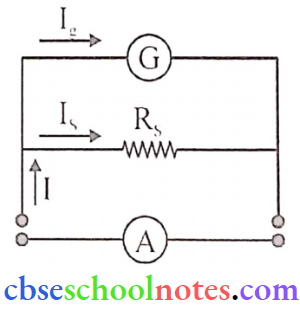
Question 10.
- State Biot – Savart law and express this law in the vector form.
- Two identical circular coils, P and Q each of radius R. carrying currents I A and √3A respectively, are placed concentric and perpendicular to each other lying in the XY and YZ planes. Find the magnitude and direction of the net magnetic field at the center of the coils.
Answer:
1. Biot-Savart Law (BSL)
According to the Biot Savart Law, the magnitude of a magnetic field \(\mathrm{d} \overrightarrow{\mathrm{B}}\) is proportional to the current I. the element length \(\overrightarrow{\mathrm{dl}}\) and inversely proportional to the square of the distance r. Its direction is perpendicular to the plane containing \(\overrightarrow{\mathrm{dl}}\) and \(\overrightarrow{\mathrm{r}}\).
The field at point P due to the current element
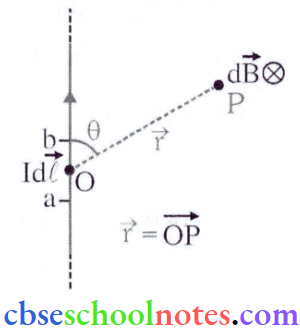
⇒ \(\mathrm{dB}=\frac{\mu_0}{4 \pi} \frac{\mathrm{Id} \ell \sin \theta}{\mathrm{r}^2}\)
⇒ \(\frac{\mu_0}{4 \pi}=10^{-7} \mathrm{Tm} / \mathrm{A}\)
μ0= permeability of free space (air/vacuum)
Vector form:
\(\mathrm{d} \vec{B}=\frac{\mu_0}{4 \pi} \frac{I \vec{dl}\times \hat{\mathrm{r}}}{\mathrm{r}^2}=\frac{\mu_0}{4 \pi} \frac{I \vec{dl}\times \overrightarrow{\mathrm{r}}}{\mathrm{r}^3}\)2. 
Given
I1 = I A (current in coil P) : I2 = √3 A (current in coil Q)
The magnetic field at the center of the circular current-carrying coil is given by
B = μ0 I/2R
So, \(B_p=\frac{\mu_0 I}{2 R}=\frac{\mu_0}{2 R}\)
∴ \(\mathrm{B}_{\mathrm{Q}}=\frac{\sqrt{3} \mu_0}{2 \mathrm{R}}\)
net field at centre(BR)
⇒ \(B_R=\sqrt{B_p^2+B_Q^2}=\sqrt{\left(\frac{\mu_0}{2 R}\right)^2+\left(\frac{\sqrt{3} \mu_0}{2 R}\right)^2}\)
So, \(B_R=\frac{\mu_0}{R}\), Direction \(\tan \theta=\frac{\mathrm{B}_{\mathrm{p}}}{\mathrm{B}_{\mathrm{Q}}}=\frac{1}{\sqrt{3}}\)
θ = 30°
Question 11.
- State Ampere’s circuital law.
- Use this law to find the magnetic field due to a straight infinite current-carrying wire.
- How are the magnetic field lines different from the electrostatic field lines?
Answer:
1. Ampere’s circuital law: The line integral of the magnetic field over a closed loop is p0 times the total current threading through that loop
⇒ \(\oint \overrightarrow{\mathrm{B}} \cdot \mathrm{d} \vec{l}=\mu_0(\Sigma \mathrm{I})\)
2. Magnetic field due to infinitely long straight current carrying conductor:
Apply Ampere’s law to find out the magnetic field at point ’p’
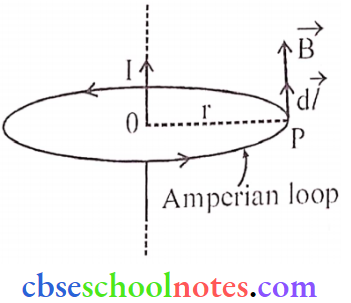
⇒ \(\oint \overrightarrow{\mathrm{B}} \cdot \mathrm{d} \vec{l}=\mu_0 \Sigma \mathrm{I}\)
⇒ \(\oint \mathrm{Bd} l \cos \theta=\mu_0 \mathrm{I} \quad\left\{\begin{array}{c}
\theta=0^{\circ} \\
\cos \theta=1 \\
\Sigma \mathrm{I}=\mathrm{I}
\end{array}\right.\)
⇒ \(\mathrm{B} \oint \mathrm{d} l=\mu_0 \mathrm{I} \Rightarrow \mathrm{B} \times 2 \pi \mathrm{r}=\mu_0 \mathrm{I}\)
⇒ \(B=\frac{\mu_0 I}{2 \pi r}\)
3. The magnetic field lines form continuous closed loops, whereas electrostatic field lines never form closed loops.
Question 12.
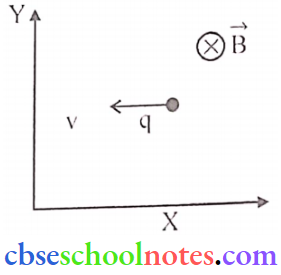
- A point charge q moving with speed v enters a uniform magnetic field B that is acting into the plane of the paper as shown. What is the path followed by the charge q and in which plane does it move?
- How does the path followed by the charge get affected if its velocity has a component parallel to \(\vec{B}\)?
- If an electric field \(\vec{E}\) is also applied such that the particle continues moving along the original straight-line path, what should be the magnitude and direction of the electric field \(\vec{E}\)?
Answer:
1. Charge q moves in a circular path. It does move in X-Y plane.
2. If velocity has a component parallel to B then charge q moves in helical path.
3. \(\overrightarrow{\mathrm{V}}=-\mathrm{V} \hat{\mathrm{i}}\)
[∵ The particle is moving along negative x-direction]
⇒ \(\vec{B}=-B \hat{k}\)
∵ The magnetic field is perpendicular to the plane of the paper directed inwards i.e. negative z-direction.
∴ Force acting due to magnetic field \(F_m=q(\vec{v} \times \vec{B})=q[-v \hat{i} \times(-B \hat{k})]\)
∴ \(\overrightarrow{\mathrm{F}}_{\mathrm{m}}=-q v B \hat{\mathrm{j}}\) (∵ \(\hat{i} \times \hat{k}=-\hat{j}\))
The magnitude of Fm = qvB, in -Y direction
For the undeflected motion of particles.
Fe = qE should be applied in \(y(+\hat{j})\) direction.
CBSE Class 12 Physics Chapter 4 Moving Charges And Magnetism Long Questions And Answers
Question 1. Amperes law gives a method to calculate the magnetic field due to a given current distribution. According to it, the circulation \(\oint \vec{B} \cdot d \vec{l}\) of the resultant magnetic field along a closed boundary is equal to p0 times the total current crossing the area bounded by the closed curve provided the electric field inside the loop remains constant. Ampere’s law is more useful under certain symmetrical conditions. Consider one such case of a long straight wire with a circular cross-section (radius R) carrying current 1 uniformly distributed across this cross-section.
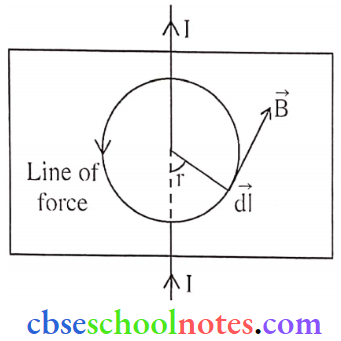
(1). The magnetic field at a radial distance r from the center of the wire in the region r > R, is
- \(\frac{\mu_0 I}{2 \pi r}\)
- \(\frac{\mu_0 I}{2 \pi R}\)
- \(\frac{\mu_0 \mathrm{IR}^2}{2 \pi \mathrm{r}}\)
- \(\frac{\mu_0 \mathrm{Ir}^2}{2 \pi \mathrm{R}}\)
Answer: 1. \(\frac{\mu_0 I}{2 \pi r}\)
(2). A long straight wire of a circular cross-section (radius a) carries a steady current I and the current I is uniformly distributed across this cross-section. Which of the following plots represents the variation of the magnitude of magnetic field B with distance r from the center of the wire?
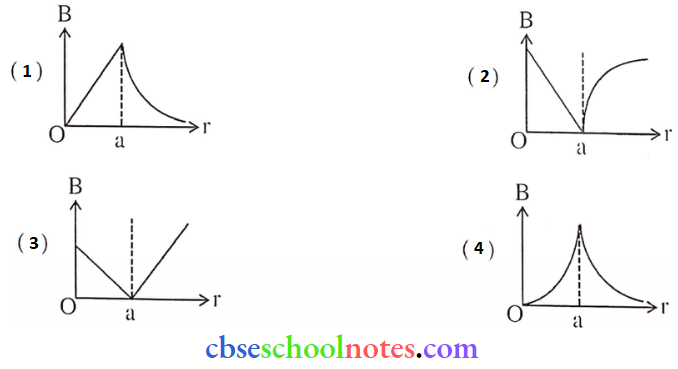
Answer: 1.
(3). A long straight wire of radius R carries a steady current I. The current is uniformly distributed across its cross-section. The ratio of magnetic field al R/2 and 2R is
- 1/2
- 2
- 1/4
- 1
Answer: 4. 1
(4). A long straight wire of a very very thin radius carries a steady current I. How magnetic field at a distance from this wire change if the value of the current in the wire is doubled?
- Doubled
- Halved
- Three times
- None of the above
Answer: 1. Boubled
Question 2. Read the case study carefully and answer the questions that follow:
A galvanometer is a device used to detect current in an electric circuit. It cannot as such be used as an ammeter to measure current in a given circuit. This is because a galvanometer is a very sensitive device, It gives a full-scale deflection for a current of the order of μA.
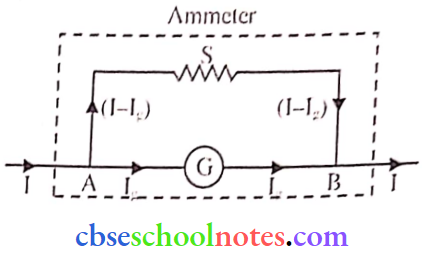
Moreover, for measuring currents, the galvanometer has to be connected in series, and it has a large resistance, this will change the value of the current in the circuit. To overcome these difficulties, we connect a small resistance Rs, called shunt resistance, in parallel with the galvanometer coil, so that most of the current passes through the shunt.
Now to use a galvanometer as a voltmeter, it has to be connected in parallel with the circuit element across which we need to measure p.d. Moreover, it must draw a very small current, otherwise, it will appreciably change the voltage that we are measuring. To ensure this a large resistance R is connected in series with the galvanometer.

Based on the information given above, answer the following questions:
(1). A sensitive galvanometer like a moving coil galvanometer can be converted into an ammeter or a voltmeter by connecting a proper resistance to it. Which of the following statements is true:-
- A voltmeter is connected in parallel and current through it is negligible
- An ammeter is connected in parallel and the potential difference across it is small
- A voltmeter is connected in series and the potential difference across it is small
- An ammeter is connected in series in a circuit and the current through it is negligible
Answer: 1. A voltmeter is connected in parallel and current through it is negligible
(2). By mistake a voltmeter is connected in series and an ammeter is connected in parallel with a resistance in an electrical circuit. What will happen to the instruments?
- Voltmeter is damaged
- Ammeter is damaged
- Both are damaged
- None is damaged.
Answer: 4. None is damaged.
(3). A galvanometer coil has a resistance of 15 Ω and gives full-scale deflection for a current of 4 mA. To convert it to an ammeter of range 0 to 6 A.
- 10 m Ω resistance is connected in parallel to the galvanometer.
- 10 m Ω resistance is to be connected in series with the galvanometer.
- 0.1 Ω resistance is to be connected in parallel to the galvanometer.
- 0.1 Ω resistance is to be connected in series with the galvanometer.
Answer: 1. 10 m Ω resistance is connected in parallel to the galvanometer.
(4). A long straight wire of a very very thin radius carries a steady current I. How magnetic field at a distance from this wire change if the value of the current in the wire is doubled?
- More
- Equal
- Less
- Zero
Answer: 1. More
Question 3.
1. An α-particle, a deuteron, and a proton enter into a uniform magnetic field normally with the same kinetic energy and describe circular paths. Find the ratio of radii of their paths.
2. Give the direction of the magnetic field acting on the current-carrying coil ACDE shown in the figure so that the coil is in unstable equilibrium.
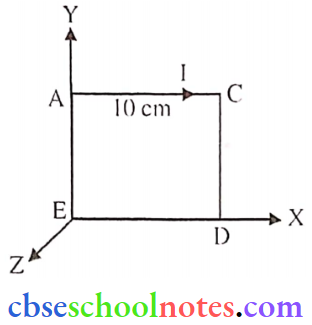
3. Why do we use a low resistance ammeter in a circuit to measure current?
Answer:
⇒ \(K=\frac{q^2 B^2 r^2}{2 m}\)
⇒ \(r=\sqrt{\frac{2 m K}{q^2 B^2}}\)
⇒ \(r=\frac{\sqrt{2 m K}}{q B}\)
K.B.2 → constant
⇒ \(r \propto \frac{\sqrt{m}}{q}\)
⇒ \(\begin{array}{c|c|c}
\alpha \rightarrow{ }_2 \mathrm{He}^{4} & \mathrm{d} \rightarrow{ }_1 \mathrm{H}^2 & \mathrm{P} \rightarrow{ }_1 \mathrm{H}^{1} \\
\mathrm{m}^{\prime}=4 \mathrm{~m} & \mathrm{~m}^{\prime \prime}=2 \mathrm{~m} & \mathrm{~m}=\mathrm{m} \\
\mathrm{q}^{\prime}=2 \mathrm{q} & \mathrm{q}^{\prime \prime}=\mathrm{q} & \mathrm{q}=\mathrm{q}
\end{array}\)
So, \(r_\alpha: r_d: r_p=\frac{\sqrt{4 m}}{2 q}: \frac{\sqrt{2 m}}{q}: \frac{\sqrt{m}}{q}\)
1:2:1
2. For an unstable equilibrium direction of the area and magnetic field must be opposite so the magnetic field must be in the Z direction.
3. So that maximum current flows through the ammeter.
Question 4.
- Draw the magnetic field lines due to a circular wire carrying current I.
- A square loop of sides 5 cm carrying a current of 0.2 A in the clockwise direction is placed at a distance of 10 cm from an infinitely long wire carrying a current of I A as shown. Calculate
- The resultant magnetic force, and
- The torque, if any, acting on the loop
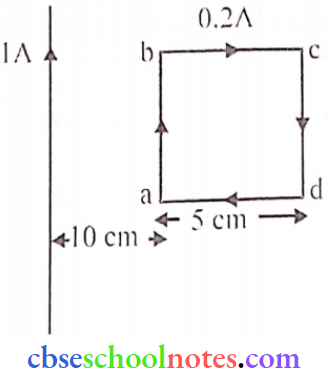
Answer:
1. Magnetic field due to a circular wire carrying current I.
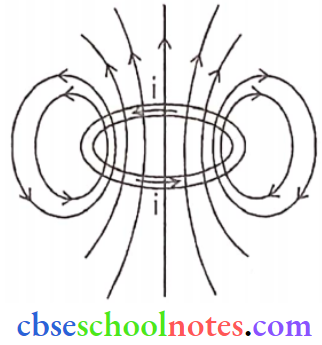
2. (1). Force on the side be an ad are same in magnitude and opposite in direction. So they cancel each other.

⇒ \(\overrightarrow{\mathrm{F}}_2=-\overrightarrow{\mathrm{F}}_4\)
⇒ \({\vec{F}}_2+\overrightarrow{\mathrm{F}}_{+}=0\)
Force on side (ab)
⇒ \(F_1=\left(\frac{\mu_0 I_1 I_2}{2 \pi d_1}\right) \times l\)
⇒ \(F_1=\left(\frac{4 \pi \times 10^{-7} \times 1 \times 0.2}{2 \pi \times 10}\right) \times 5\)
⇒ \(\mathrm{F}_1=2 \times 10^{-8} \mathrm{~N}\) (towards left)
Force on side (cd)
⇒ \(\mathrm{F}_3=\left(\frac{\mu_0 \mathrm{I}_1 \mathrm{I}_2}{2 \pi \mathrm{d}_2}\right) \times l\)
⇒ \(F_3=\left(\frac{4 \pi \times 10^{-7} \times 1 \times 0.2}{2 \pi \times 15}\right) \times 5 \Rightarrow F_3=\frac{4}{3} \times 10^{-8} \mathrm{~N}\)
The resultant force on the loop,
F = F1-F2 (∵ F1 and F3 are oop.)
\(\)\left(2-\frac{4}{3}\right) \times 10^{-8} \Rightarrow \mathrm{F}=\frac{2}{3} \times 10^{-8} \mathrm{~N} (towards left)
(2). Torque on square loop ‘Abcd’
τ = MB sinθ (∵ θ = 0)
τ = 0
Question 5.
- With the help of a neat and labeled diagram, explain the principle and working of a moving coil galvanometer.
- What is the function of a uniform radial field and how it is produced?
- Define the current sensitivity of a galvanometer. How is current sensitivity increased?
Answer:
1. Principle: When the current-carrying coil is placed in a magnetic field it experiences a torque.
τ = NI AB → (1)

It consists of a plane coil of many turns suspended in a radial magnetic field. When a current is passed in the coil it experiences a torque which produces a twist in the
suspension.
This deflection is directly proportional to the torque
τ= KΦ → (2)
By equation (1) and (2)
∵ N1AB = KΦ;
⇒ \(I=\left(\frac{K}{N A B}\right) \phi\);
K = elastic torsional constant of the suspension
⇒ \(\mathrm{I}=\mathrm{C} \phi ; \mathrm{C}=\frac{\mathrm{K}}{\mathrm{NAB}}\)
C ⇒ Galvanometer constant
So I ∝ Φ
τ ∝ I
Galvanometer:
An instrument used to measure the strength of current by measuring the deflection of the coil due to torque produced by a magnetic field.
τ ∝ i∝θ
Current Sensitivity (CS)
It is defined as the deflection per unit current.
⇒ \(C S=0 / I=\frac{N A B}{K}\)
Voltage Sensitivity (VS)
It is defined as deflection per unit voltage.
⇒ \(V S=\phi / V=Φ / I R=\left(\frac{N A B}{K R}\right)\)
2. The function of radial field, is.
- To maximize the deflecting torque acting on the current carrying coil.
- To increase the strength of the magnetic field.
The radial magnetic field is produced by using a concave magnetic pole. Also cylindrical soft iron core helps in the production of the radial magnetic field.
3. Current sensitivity is the deflection shown by the galvanometer for a unit current flow.
⇒ \(I_S=\frac{\phi}{I} \text { or } \frac{N A B}{K}\)
Where Φ is the deflection in the coil.
The current sensitivity of the galvanometer can be increased by
- Increasing the number of turns (N )
- Increasing magnetic induction (B)
- Increasing area of coil (A)
- Decreasing the couple per unit twist of the spiral springs.
Question 6.
- Use it to obtain the expression for the magnetic field at an axial point situated at distance d from the center of a circular coil of radius R carrying current I.
- Also, find the ratio of the magnitudes of the magnetic field of this coil at the center and at an axial point for which x = R√3.
Answer:
1. Vector form of Biot-Savart’s law
⇒ \(d \vec{B}=\frac{\mu_0 I}{4 \pi r^2}(d \vec{l} \times \hat{r})\left\{\hat{r}=\frac{\vec{r}}{r}\right.\)
The magnetic field at an axial point of a current-carrying circular loop:
⇒ \(d\vec{B}=\frac{\mu_{0} \mathrm{I}}{4 \pi \mathrm{r}^3}(\mathrm{~d} \vec{l} \times \overrightarrow{\mathrm{r}})\)

Magnetic field due to the small element at point ‘P’
⇒ \(\mathrm{dB}=\frac{\mu_0 \mathrm{Id} l \sin \theta}{4 \pi r^2}\)
Angle between \(d\vec{l}\) and \(\hat{r}\) is always 90 ( = 90°). The direction of the magnetic field is perpendicular to the plane of \(d\vec{l}\) and \(\hat{r}\).
⇒ \(\mathrm{dB}=\frac{\mu_0 \mathrm{Id} l}{4 \pi \mathrm{r}^2}\left\{\sin 90^{\circ}=1\right.\)
The total magnetic field at point P
⇒ \(\mathrm{B}_{\text {axis }}=\int_0^{2 \pi \mathrm{R}} \mathrm{dB} \sin \phi\) ⇒ \(\mathrm{B}_{\mathrm{axis}}=\int_0^{2 \pi \mathrm{R}} \frac{\mu_0 \mathrm{Id} l}{4 \pi \mathrm{r}^2} \times \frac{\mathrm{R}}{\mathrm{r}}\left\{\sin \phi=\frac{\mathrm{R}}{\mathrm{r}}\right.\)
⇒ \(\mathrm{B}_{\mathrm{axis}}=\frac{\mu_0 \mathrm{IR}}{4 \pi \mathrm{r}^3} \int_0^{2 \pi \mathrm{R}} \mathrm{d} l\) ⇒ \(B_{\text {axis }}=\frac{\mu_0 I R}{4 \pi r^3} \times 2 \pi R\) ⇒ \(\mathrm{B}_{\mathrm{axis}}=\frac{\mu_0 \mathrm{IR}^2}{2 \mathrm{r}^3}\)
⇒ \(B_{\mathrm{axis}}=\frac{\mu_0 I R^2}{2\left(R^2+x^2\right)^{3 / 2}}\left\{r=\left(R^2+x^2\right)^{1 / 2}\right.\)
⇒ \(B_{\text {axis }}=\frac{\mu_0 \text { NIR }^2}{2\left(R^2+x^2\right)^{3 / 2}}\)

2. At the center of the current loop
⇒ \(B_0=\frac{\mu_0 N I}{2 R}\)
At the axial point x = R√3
⇒1\(B_1=\frac{\mu_0 NI R^2}{2\left(R^2+3 R^2\right)^{3 / 2}}=\frac{\mu_0 NI R^2}{2 \times 8 R^3}\)
⇒ \(\frac{B_0}{B_1}=\frac{\frac{\mu_0 N I}{2 R}}{\frac{\mu_0 N I}{2 \times 8 R}}=8: 1\)
